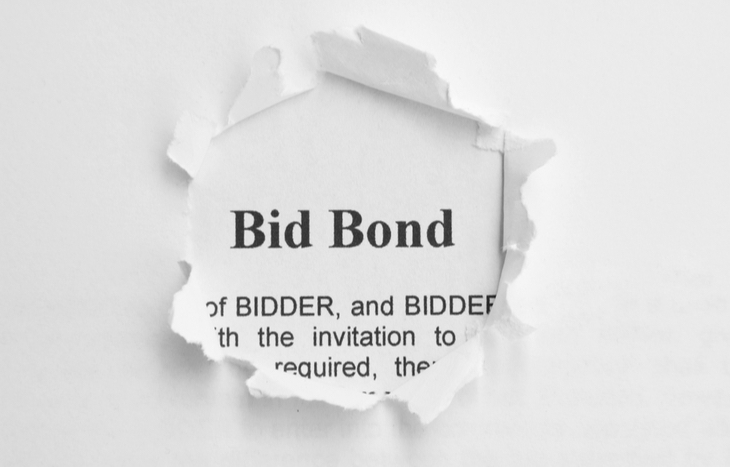What is a Bid Bond?
When municipalities contract companies and craftspeople to complete projects, they need some level of guarantee that the work they’re paying for will get done accordingly. As they field bids from eager contractors, organizations might ask for a bid bond to protect themselves.
A bid bond is a type of surety bond that guarantees a payout pending certain stipulations. In the case of large-scale construction projects, the bond pays out if the contractor fails to honor their bid, doesn’t deliver within the agreed-upon parameters or simply doesn’t begin the project. These types of bonds are very common in commercial construction. Moreover, they are mandated for state and federal development projects.
Bid bonds are standard practice for most construction projects, and they’re broadly applicable any time there’s a project involving skilled contractors. Here’s a closer look at how they’re used, the protections they offer and the benefits of using them.

Breaking Down a Bid Bond
There are three parties involved in a bid bond: the obligee, the principal and the guarantor. All three work together to create a covenant of accountability before a project starts:
- The obligee is the owner that will make a bond claim if the contractor fails to deliver.
- Principal is the contractor responsible for purchasing the bond as a sign of trust.
- Guarantor is the surety company facilitating the issuance of the bond at a premium.
It’s best to think of the guarantor as the middleman. The principal works with the guarantor to establish the bond based on its trustworthiness and credit rating. Once issued, the principal submits that bond to the obligee as a show of their credibility. If selected and the principal fails to deliver, the obligee files a claim to the guarantor for the bond.
An Example of How Bid Bonds Work
To show the importance of a bid bond in practice, it’s best to look at a common example: construction. Large municipal construction projects use bid bonds as a form of surety, and the practice looks something like this:
Big Bob’s Builders submits a $10 million bid on a commercial construction project, with a 10% bid bond ($1 million). If Big Bob’s Builders doesn’t begin the project at the agreed-upon $10 million, the municipality can evoke the bid bond claim of $1 million to cover the cost of overage or the cost to have someone else finish the project.
The reason bid bonds are so prevalent in construction is due to the extremely high costs and timeline of these projects. Project owners pay construction companies as they go, instead of at the project’s culmination. Bid bonds offer them some protection against disruptions that may take place over the course of the project.
Requirements
Bid bonds come with a few general stipulations that have become industry standards. Specifically, here’s what to expect in the event of most bid bonds:
- Bond values are 10% of the contracted amount; 20 % for federal projects.
- Guarantors perform extensive credit and background checks to determine bond premium.
- Once approved, principals submit bid bonds during the tender stage of a project.
Ultimately, a tendered bid with an accompanying bond represents a good-faith bid on a project. It provides project owners with some peace of mind that if you’re awarded the contract, you’ll follow through or they’ll receive compensation.
Agreement to Bond and Additional Bonds
Once a contractor wins a bid, there’s an Agreement to Bond. This is a notarized document with the bond company that stipulates the issuance of both a Performance Bond and Labor/Materials Bond. These bonds serve relatively the same purpose: to protect the project owner against default or overages.
- Performance Bonds ensure all work is complete on-time, within-budget and to-spec.
- Labor/Materials Bonds ensure all vendors and workers get paid for their contributions.
Performance Bonds and Labor/Materials Bonds are secondary to bid bonds, representing the next level of surety after the project manager accepts a bid during the tender stage. The cost of a Performance Bond is usually very low. It’s usually less than 1% of the contract. Labor/Materials Bonds are even lower between 0.25% and 0.5% of the contract price.
How to Qualify for Bid Bonds
Contractors (principals) coordinate with guarantors (surety bond companies) to qualify for bid bonds. Typically, this means two evaluative steps: operations and finances:
- When evaluating operations, the bond company will assess past projects you’ve done, business structure, assets and your general ability to perform the work you’re trying to bid on. The more capable you are, the less the bond premium.
- When looking at finances, the bond company wants to see healthy cash flow, liquidity and the ability to cover upfront costs for things like labor and materials. This also includes lines of credit and even personal finances.
Based on these factors, guarantors will either accept or decline the request for a bond. If accepted, they’ll rate the premium (cost) of the bond based on the strength of the company.
Failure to Meet Obligations
If a contractor fails to meet expectations, backs out of the project or breaks the agreement in a way that costs the project owner money, they’re entitled to file a claim against the bond for a Failure to Meet Obligations. In fact, this can mean one of two things. With option one, the guarantor will pay out the full value of the bond to the project owner as compensation. In option two, the guarantor will pay out the difference of the bond between the accepted bid and the next lowest bidder. Nevertheless, the project owner gets the protection they need.





